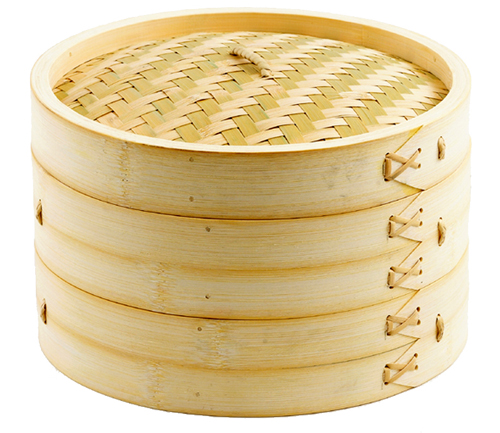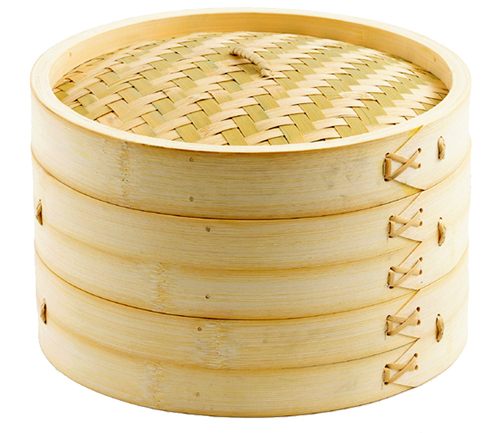
Bamboo steamer is often found in many Asian cuisines. This traditional cooking tool has been used for many centuries because they are practical and very inexpensive. Bamboo steamers come in variety of sizes with elegant designs to meet the needs of different chefs. They are can be purchased at your nearest department stores and gourmet cooking stores. It is typically made of bamboo that consists of individual cooking trays or layers with openings in the bottom. They are assembled together and used to steam the food. In many Chinese restaurants, dim sum and dumplings are best cooked in a bamboo steamer. Moreover, with the increasing number of health-conscious individuals, steamers are found to be widely used to cook almost all kinds of food, from vegetables to meat, to poultry, to seafood, to fruits or pasta.
Steaming is a method of cooking that makes use of boiling water. In this method, the food does not come into direct contact with water but rather it is cooked by the steam or water vapor from the boiling water just below it.
Advantages of steam cooking
Eating foods that are rich in nutrients has been a part of our healthy living but we should also consider that cooking methods also affects the nutrient value of these foods. Unlike other cooking methods such as boiling, frying, or sautéing, steaming food produces a more flavorful and enhances its texture while retaining the essential vitamins and minerals in various foods. Steaming provides a temperate heat which slowly diffuses through the food while allowing the food cook in its own juice hence preventing the loss of nutrients. It also allows you to cook different food items on a single heat source over perforated tiers using the same steam. This method does not only save your precious energy but also saves more energy and money. Steaming is also great for those who want to lose weight. Whether it is pork, chicken, or lamb, steaming helps eliminate the extra fat found on these foods. It removes the fat from the meat, leaving it in the water to be discarded. Furthermore, it lets you cook delicious food without using fat, oils, and butter. Because it simply gets rid of fats, you are assured that the meat you are eating is low in calories and cholesterol.
How to Use a Bamboo Steamer
The proper use of a bamboo steamer saves you so much time spent on cleaning and washing hardened leftovers and juices. To begin with, simply fill the bottom of the wok with at least 2 inches of water. You can place the food directly on the steamer baskets or you can layer each tray with lettuce leaves, cabbage leaves, or parchment paper to prevent the food from sticking to the basket. Repeat these steps for each section of the steamer you are using. Make sure to place the food that needs long hours of steaming on the bottom. Place the bottom layer of your steamer in the wok and ensure that it sit above the water line and doesn’t get submerged. Stack the other steamers you will be using on the top. This time you can now turn on the stove burner and bring it to a boil. Add more water in the pot once it starts to go dry until the desired cooking time is finished.
Caring for a bamboo steamer
Bamboo is known for its durability and could stand various elements that come along the way. With the right care and proper cleaning, these bamboo steamers will surely last for many years. Unlike other kitchen cookware, bamboo steamers should not be washed with soap because it easily absorb when it comes in contact with the bamboo, making your next dish taste soapy. The best way to clean a bamboo is to wash it right away after you’ve cooked in it.
If there are hardened juices or leftover food in the bamboo steamer then you can simply do a gentle brushing until all the hardened juices of leftovers are gone. Make sure to use a soft brush and brush gently to avoid breakage or complete damage to the bamboo steamer. Then rinse the steamer with lukewarm water and gently blot it with a soft cloth to remove excess water. Once done, set it aside and let it dry completely before putting it away.
To prevent the bamboo to dry out too much, you should oil the bamboo to keep it moist. Make use of some oil that does not have any flavor in it. Apply an adequate amount of clear vegetable oil on a soft dry cloth then gently wipe it on the bamboo. You can then use it right away or put it back into the storage.
Bamboo Steamers vs. Metal Steamers
Aside from bamboo steamers, metal steamers are also a popular kitchen tool for many chefs. While both have its own advantages and disadvantages, the choice of steamer depends on your preferences. Metal steamers are often described as a stainless flower-like shape with holes.
A metal steamer doesn’t take up much of your time in cleaning. With just a mild detergent and a splash of water and you are done. Bamboo steamers on the other hand are not washed with soap as it may affect the flavor of your dish. Furthermore, you need to do a little brushing once there are foods or hardened juices that are left on the steamers.
Metal steamers take up only a little space than the many layers of bamboo and do not require stovetop space. After washing, metal steamers can be wiped and stored immediately in your kitchen while bamboo steamers should be dried completely before storing to avoid damage to the material.
Many claim that bamboo steamers give more authentic oriental flavor than the metal ones. Bamboo steamers snugly fit when you stack multiple layers giving you the convenience of steaming several dishes at once. In this way, you can save time and effort in cooking. The thing that these bamboo steamers don’t accidentally slide down is a really big help.
Bamboo steamers are more durable than the metal ones and may last longer. Sometimes metal steamers are a little bit fragile and may break easily. Bamboo steamers are also stylish making it perfect to stack on a buffet table.
